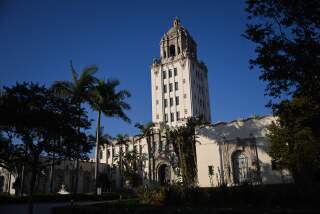Founded in 1914 with the help of...
- Share via
Founded in 1914 with the help of some of the silver screen’s greatest stars, Beverly Hills has long enjoyed the reputation of being a city of wealth and style.
Over the decades it has gained fame as the place where celebrities frolicked on polo ponies, met for grand, decadent parties, and spent large sums on mansions along broad, tree-lined streets.
And although the polo ponies have been replaced by the Polo Lounge, and the show business parties are just as likely to happen in Malibu, some people contend that little has changed in Beverly Hills.
Movie stars still live on the tony streets north of Santa Monica Boulevard. Rodeo Drive is known throughout the world as a glamorous thoroughfare of appointment-only boutiques, and the cost of most items epitomizes the saying: “If you have to ask the price. . . .”
But the glamour does not extend to all the streets in Beverly Hills. More than 28% of the households have annual incomes of less than $30,000. And in the city of mansions, more than half of the homes are apartment rentals.
Since its inception, Beverly Hills has sought to maintain the appearance of exalted standards and an air of exclusivity.
After founder Burton Green attempted to find oil on the land but struck water instead, he and his partners decided to develop a community that would be the “ideal residential garden spot,” said Phyllis Lerner, vice president of the Beverly Hills Historical Society.
What evolved was essentially a movie colony as stars in the budding film industry were shunned from living in other communities, being considered too wild and staying up too late, Lerner said.
Film stars Mary Pickford and Douglas Fairbanks were some of the earliest residents, showing off their famous home “Pickfair” and enticing actors Charlie Chaplin, Will Rogers and Tom Mix to move to Beverly Hills.
*
The lifestyle was grand as the movie business thrived and money poured into the community.
Comedian Buster Keaton built an Italian-style villa on three acres, with a waterfall cascading down a hillside into a swimming pool. William Randolph Hearst had a mini-Hearst Castle constructed for Marion Davies at Lexington Road and Hartford Way--the estate was so large that actor John Barrymore was said to have gotten lost during a party and was missing for three days.
Life was so good, in fact, that Fairbanks once suggested that a wall be constructed around the city to sustain its exclusivity. (The idea
was rejected by merchants who balked at losing business.)
Rodeo Drive had its own humble beginnings as farmhouses lining the street. Green soon paved the roads and added alleyways so people would not be disturbed by the sight of commercial vehicles making deliveries.
Now, more than 80 years later, Beverly Hills is still a city characterized by extravagance and eccentricity.
It is here that a Middle Eastern sheik painted anatomically correct hair on marble statues on his front lawn on Sunset Boulevard. The same city that paid more than $120 million for its lavish Civic Center. And where a billionaire attempted to build a 40-room mansion in the hills but lost a fight with millionaire neighbors and film stars who opposed the house.
As the early years indicated, Beverly Hills remains a pocket of singularity with a style all its own.
(BEGIN TEXT OF INFOBOX / INFOGRAPHIC)
By The Numbers
City Business
Incorporated: Jan. 28, 1914
Area in square miles: 5.69
Number of parks: 12
City employees: 608 full time.
1995-96 budget: $150 million
*
People
Population: 31,971
Households: 14,518
Average household size: 2
Median age: 43
*
Ethnic Breakdown
Asian: 5%
Black / Other: 2%
Latino: 5%
White: 87%
*
Money and Work Median household income: $54,397
Median household income / L.A. County: $34,965
Median home value: $738,000
Employed workers (16 and older): 16,810
Percentage of women employed: 55%
Percentage of men employed: 74%
Self-employed: 2,821
Car- poolers: 1,294
*
Retail Stores
Number of stores: 859
Number of employees: 9,028
Annual sales: $1.3 billion
*
Families:
Married couples with children: 17%
Married couples with no children: 28%
Non-family households: 45%
Other types of families: 10%
Source: Claritas Inc. Household expenses are averages for 1994. All other figures are for 1990. Percentages have been rounded to the nearest whole number.
More to Read
Inside the business of entertainment
The Wide Shot brings you news, analysis and insights on everything from streaming wars to production — and what it all means for the future.
You may occasionally receive promotional content from the Los Angeles Times.










